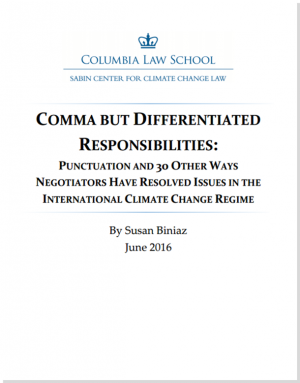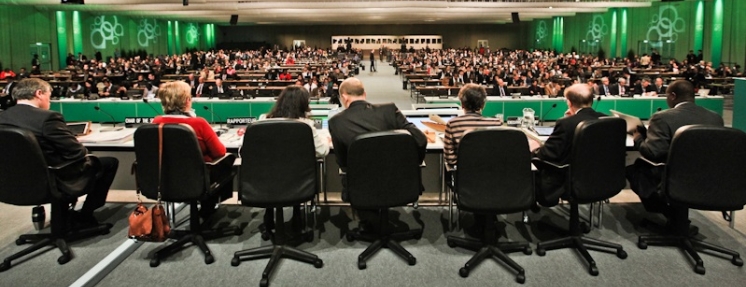By Susan Biniaz (Susan Biniaz is a former Deputy Legal Adviser at the U.S. Department of State, as well as the Department’s lead climate lawyer from 1989 through early 2017. She is currently a Senior Fellow at the UN Foundation and on the adjunct faculty at Columbia and Yale Law Schools.)
On August 4th, the U.S. Mission to the United Nations notified the UN Secretary-General that it “intends to exercise its right to withdraw” from the Paris Agreement. The U.S. State Department simultaneously issued a media note containing additional details. Several questions have arisen in connection with the communication, the answers to which are found below.
Is the U.S. communication an official notice of withdrawal?
No. The communication makes clear that it is only a notice of “intent” to withdraw. It expressly provides that a formal written notification of withdrawal will be submitted once the United States is eligible to do so. (It will be eligible to do so as of November 4, 2019, i.e., three years after the Agreement entered into force for the United States.)
Does the communication have any legal effect?
No. Whatever its effect, it is not legal. It does not itself trigger the withdrawal process under the Agreement.
Was the United States required to send this type of notice of “intent” to withdraw?
No. There is no requirement, under the Paris Agreement or otherwise, to give advance notice of withdrawing.
What then was the purpose of the communication?
The communication states that its purpose is “transparency” with respect to Parties to the Agreement.
Does the communication leave the door open to remaining a Party to the Agreement?
As a legal matter, yes. As noted above, it is not a formal notice of withdrawal.
As a policy matter, it appears to leave the door open as well. The communication states that the United States will submit a formal notification of withdrawal, unless it “identifies suitable terms for reengagement.” The media note reiterates this point, stating that the President, as he himself has indicated, is “open to re-engaging in the Paris Agreement if the United States can identify terms that are more favorable to it, its businesses, its workers, its people, and its taxpayers.”
Is there any indication of what the “suitable terms” or “more favorable” terms might be?
It is unclear from the communication and media note what the Administration would consider suitable/more favorable terms for reengagement. It is also unclear whether such terms would require the agreement of other Parties to the Agreement or could be secured in other ways.
In theory, there are at least four ways in which the United States could establish different terms of participation:
- At one end of the spectrum, the United States could seek to renegotiate aspects of the Agreement itself. If so, it has given no indication of which provisions it has in mind. Further, several key countries have seemingly made clear (through repeated statements that the Agreement is “irreversible”) that this is not an option for them.
- At the other end of the spectrum, it could modify its “nationally determined contribution,” i.e., the U.S. emissions target. There would be no need to get the agreement of other Parties to do so. The Administration’s criticisms of the Agreement have largely focused, albeit indirectly, on the current U.S. emissions target; the media note also appears to be addressing this issue when it refers to the Administration’s support for a “climate policy that lowers emissions while promoting economic growth and ensuring energy security” and its intent to continue “to reduce our greenhouse gas emissions through innovation and technology breakthroughs….”
- A third option would be for the United States to seek “suitable” or “more favorable” terms within the Paris-related guidelines that are currently being negotiated. The Agreement left certain details for further elaboration, such as with respect to the transparency framework for reporting and review. Such guidelines, which are due to be completed in 2018, could conceivably – perhaps in combination with a new U.S. emissions target – form the basis for terms that are acceptable to the Administration. It is perhaps for this reason that the media note states that the United States will continue to participate in the Paris-related negotiations, “to protect U.S. interests and ensure all future policy options remain open to the administration.”
- The United States might also seek improved terms outside the framework of the Agreement, such as through bilateral or multilateral energy-related cooperation.
Does the communication break any new ground?
The core aspects of the communication, i.e., that the United States “intends” to withdraw “unless” improved terms of participation are found, appear to be consistent with the President’s original announcement regarding withdrawal, as well as his statement in Paris alongside President Macron of France.
One seemingly new feature is the communication’s reference to Article 28.1 of the Agreement as the provision under which the United States would intend to withdraw in the future. The President’s original announcement suggested (but did not say explicitly) that the United States would be withdrawing only from the Paris Agreement, not also from the Framework Convention on Climate Change (which the United States joined in 1992). Withdrawal from the Convention would have accelerated withdrawal from the Paris Agreement by a few years, but would have been perceived as an even more dramatic walk-back from international climate engagement. This communication, by referring to Article 28.1 (instead of Article 28.3) makes clear that the intent is to withdraw from Paris only.
In addition, the media note makes clearer than did previous Administration statements that the United States will continue participating in the UNFCCC process, including the Paris-related negotiations.
Why was the notification sent to the UN Secretary-General, as opposed to the Secretariat of the UNFCCC?
Under the terms of the Paris Agreement, notifications regarding withdrawal are to be sent to the Depositary of the Agreement, which is the UN Secretary-General. (The Depositary also receives instruments of ratification, approval, etc., and maintains the official record of which States are Parties.)
In sum, the purpose of the communication, if there is one beyond “transparency,” remains unclear. It is not legally necessary to preview with the Depositary a future withdrawal, and the notice has no legal effect. The content largely tracks past Presidential statements concerning the intent to withdraw coupled with the possibility of “re-engaging,” and it does not offer any specifics as to which “suitable” or “more favorable” terms the Administration seeks. At the same time, it clarifies that the intent to withdraw applies to the Paris Agreement only and that the United States will continue to participate in Paris-related negotiations.




